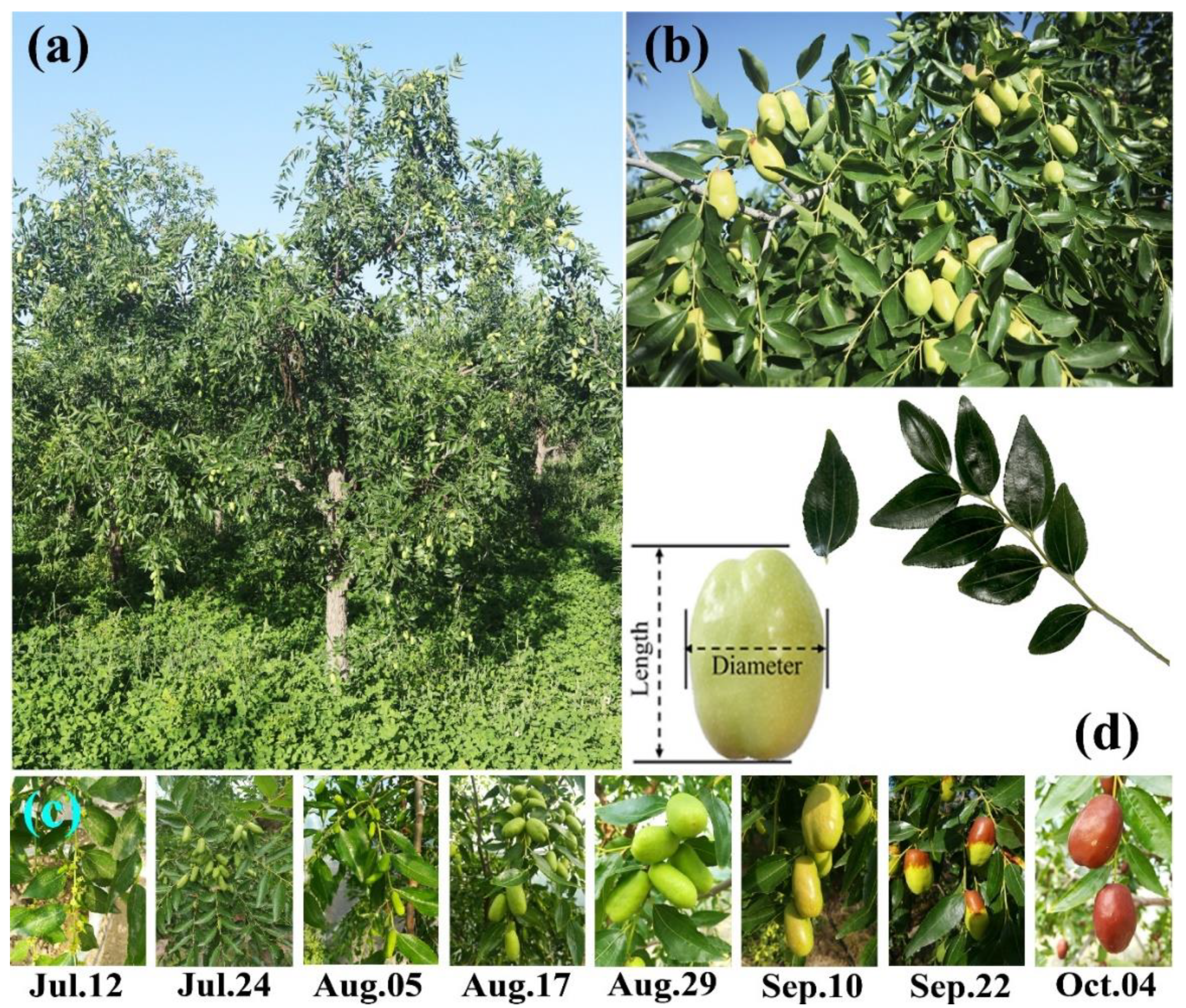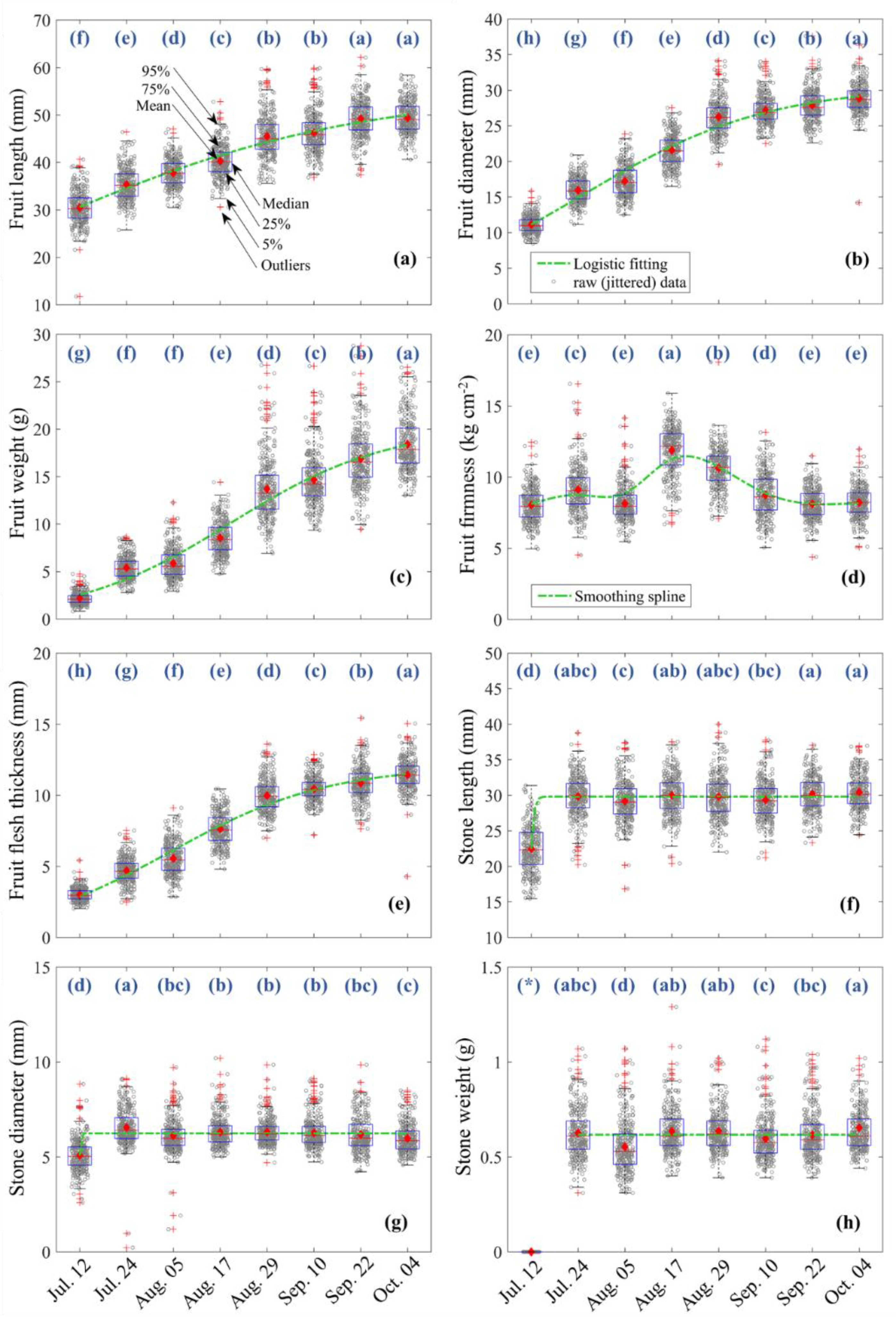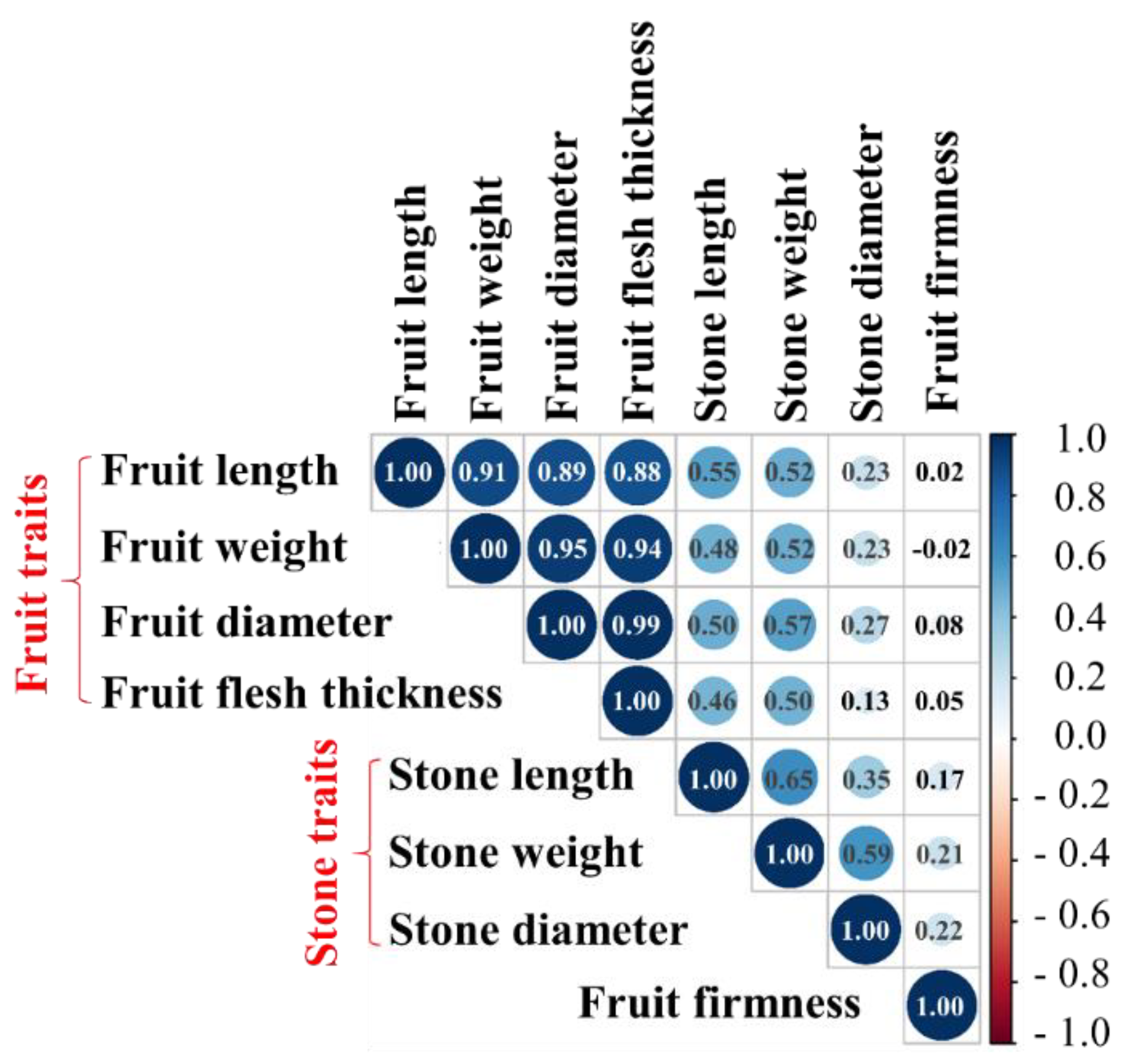1. Introduction
Chinese Jujube (jujube, red date, Chinese date) belongs to the
Ziziphus species in the Rhamnaceae family. It is native to China and has been cultivated for 700–800 years [
1,
2]. Chinese Jujube has outstanding adaptability, nutritious fruits, and multi-purpose utilization in food and traditional medicine, and it is an ideal economic crop in arid and semiarid regions under temperate and subtropical climate. The annual production of jujube in China is >1.1 × 10
10 kg, supporting a market value of over
$14 billion [
1].
Jujube cultivars are typically classified according to the purpose of consumption and utilization. Some are cultivated for fresh eating, some are good for drying and food processing. ‘Lingwu Changzao’ (
Ziziphus jujuba Mill.
cv. Lingwuchangzao) is a high quality fresh-eating cultivar in Ningxia, China, featured for its superior taste, texture, and high fruit/stone ratio. The annual production of ‘Lingwu Changzao’ reached ~1.8 × 10
7 kg, with a total cultivation area of ~4.5 × 10
7 m
2 in 2017 [
3,
4].
With an expansion of the fresh-eating jujube market and an increasing consumer demand for fruit quality and appearance, it is imperative to select jujube cultivars with desirable fruit morphology. Fruit morphological traits include fruit color, fruit size, fruit shape, flesh (mesocarp) weight, and stone weight. Remarkable variations of fruit morphological traits have been reported in a range of jujube cultivars [
5]. Quantitative traits, such as fruit size and fruit weight are yield components, whereas other traits, such as skin color, fruit shape, fruit firmness (also known as fruit hardness), and fruit/stone ratio, are quality attributes. Since some quality attributes can be expressed with quantitative traits (e.g., fruit shape is defined by the ratio of fruit length and diameter, fruit/stone ratio is computed with fruit flesh weight and stone weight), quantitative morphological traits become critical in demarcating fruit yield and fruit quality.
Measurements of quantitative morphological traits are relatively easy. Observing the changes of quantitative traits during a completed jujube fruit developing period not only enhances our understanding of the fruit growth patterns, but also provides references for field management in improving fruit yield and quality. For example, the ideal time for fertilization and irrigation could be the flesh growth period rather than stone growth period. A standard dataset that presents the jujube fruit development under a variety of ambient conditions, such as weather or field managements, can also support decisions in plant breeding. However, for under-investigated fruit tree crops, such as ‘Lingwu Changzao’, dataset for fruit and stone morphological traits have been rarely reported. Therefore, a study of ‘Lingwu Changzao’ fruit morphology, with multiple fruit and stone traits over a completed fruit growth period, is necessary.
The objectives of this study are to measure the growing patterns of eight selected fruit morphological traits during jujube fruit development, including four fruit traits (fruit length, fruit diameter, fruit weight, and fruit flesh (mesocarp) thickness), three stone traits (stone length, stone diameter, and stone weight), and fruit firmness.
2. Materials and Methods
‘Lingwu Changzao’ fruit trees were planted in an orchard of the Ningxia University Horticultural Research Station, located in Yongning County, Ningxia, China (38.78° N, 106.07° E, 1117 m in altitude). The experiment site was of arid continental climate, with an annual frost-free period of 140–160 d. The annual average sunshine was 3000 h, and the average temperature and precipitation were 8.5 °C and 180–300 mm [
6]. The orchard was of 3300 m
2. Fruit trees in the orchard were 4-yr-old (
Figure 1a), with an average height of 1.7 m. Each tree occupied an area of 2 × 3 m
2. Thirty healthy fruit trees were randomly selected for this study.
Eight measurements were performed from early fruiting (12 July 2017) to fruit ripening (4 October 2017), and consecutive measurements were separated by a 12-d interval. For each measurement, 10 fruit samples from one single fruit tree were hand-harvested.
Figure 1c presents the photographs of the jujube fruits on the sampling dates. Fruit length, fruit diameter, flesh thickness, stone length, and stone diameter were determined with a digital caliper of 0.01 mm resolution (
Figure 1b). Fruit weight and stone weight were obtained with an electronic scale. Fruit firmness (kg cm
−2) of each jujube fruit was the average value of two measurements at opposite sides near the fruit equatorial zone. A GY-4 digital fruit penetrometer (Zhejiang Top Instrument Co. Ltd., Hangzhou, China) with a 3 mm diameter probe was used to determine the firmness values, and a small piece of skin was removed from the fruit surface before firmness measurements. Stone traits were determined after the fruit flesh was completely removed.
Observed results were analyzed with Tukey’s HSD multiple comparisons, performed at a significance level of 0.01. Furthermore, Pearson analysis was applied to identify the correlation among the measured morphological traits and investigate the relations between morphological traits and yield.
3. Results and Discussion
Box plots in
Figure 2 represent the growing patterns of the selected morphological traits during the experiment period. Within each box, the center red line represents the median value, while the red diamond represents the mean value. The upper and lower edges of a given box present the 25% and 75% percentiles, while the whiskers extend to the most extreme data points that are not considered as outliers, i.e., 5% and 95% percentiles. Box plots also imply data normality, i.e., medians and means are similar, and upper and lower box edges, as well as whiskers are nearly symmetric about the means. The green dash lines present the fitted Logistic growth curves, except for the fruit firmness, where a smoothing spline is applied to show its “blow-off top” pattern. The Tukey’s HSD multiple comparison results for each trait are marked with blue letters (
Figure 2).
Figure 3 presents the Pearson correlation analysis among the selected morphological traits at a significance level of 0.01. The correlation coefficients are shown in
Figure 3 and represented with dot-size and dot-color.
The growth of selected traits followed three patterns. Four fruit traits increased with respect to time, coinciding with a double ‘S’ growth curve reported in [
7,
8]. The growth rates were maintained relatively large during the whole experiment period; therefore, in general, values of the fruit traits in two consecutive measurements showed significant differences. Fruit diameter, fruit weight, and fruit flesh thickness had continuously increasing patterns, especially near the end of the experiment period. However, for fruit length, no significant differences were shown between 29 August and 10 September and between 22 September and 4 October. That implied the existence of a turning point, where the increases of fruit length gradually terminated, while the increases of fruit diameter, fruit weight and fruit flesh thickness continued. The differences between fruit length and the other three fruit traits can also be observed in
Figure 3, where the correlation between fruit length and fruit diameter, fruit weight or fruit flesh thickness are relatively weak (~0.9) comparing to the correlation coefficients among fruit diameter, fruit weight and fruit flesh thickness (~0.95). That also explained the fact reported in [
3], where comparing to fruit length, fruit diameter could be an appropriate feature to represent the fruit yield. Because of the importance of fruit traits in yields, the fitted Logistic growth curves for the four selected fruit traits are summarized in
Table 1, using the toolbox proposed by [
9].
During the early experiment period, stone traits presented a steep increasing growing pattern, and then maintained constant (
Figure 2f–h). Although some significant differences were shown for stone traits near the end of the experiment period, the absolute differences among the measured values were essentially small. Stones usually account for 10~15% of the total fruit weight and somehow influence fruit length [
10]. However, for ‘Lingwu Changzao’, stone growth nearly stopped in the early experiment period, such that stone length occupied ~60% of fruit length, while stone weight was only ~6% of fruit weight. Hence, ‘Lingwu Changzao’ had a relatively high fruit/stone ratio [
11,
12,
13].
Fruit firmness is presented in
Figure 2d. The values were roughly constant at the beginning, then increased to the maximum on 17 August; after that, fruit firmness values gradually decreased to a stable value. Such a pattern was different from any other morphological traits considered in this study. Hence, the correlation coefficients between fruit firmness and other traits achieved relatively small values (
Figure 3).
4. Summary
In this study, morphological traits of jujube cultivar ‘Lingwu Changzao’ (Ziziphus jujuba Mill. cv. Lingwuchangzao) were measured over a completed fruit developing period. Four fruit traits (fruit length, diameter, weight, and flesh thickness) presented relatively stable growing patterns during the experiment period; the growing speed of three stone traits (stone length, diameter, and weight) was initially large, but reduced to nearly zero later; the fruit firmness (also known as fruit hardness) increased from constant trend to a maximal value and then decreased. Pearson correlation analysis indicated strong correlations among fruit diameter, flesh thickness, and fruit weight. In conclusion, fruit diameter and fruit flesh thickness are main contributors to fruit yield; with early termination of stone growth, the biological basis of the high fruit-stone ratio in ‘Lingwu Changzao’ is proved. Future research should include the studies to dissect and quantify genotype effects, while multi-year experiments should be performed to identify the responses of fruit morphology to a variety of weather conditions and complete a standard dataset to support jujube cultivation in China.









